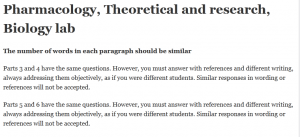Pharmacology, Theoretical and research, Biology lab

The number of words in each paragraph should be similar
Parts 3 and 4 have the same questions. However, you must answer with references and different writing, always addressing them objectively, as if you were different students. Similar responses in wording or references will not be accepted.
Parts 5 and 6 have the same questions. However, you must answer with references and different writing, always addressing them objectively, as if you were different students. Similar responses in wording or references will not be accepted.
Part 1: Advance pharmacology
Ms. Jones brings 6-week-old Sam to the clinic because of a bright red rash in the diaper area that has gotten worse since she started putting over-the-counter antibiotic cream on it 3 days ago. Sam is diagnosed with diaper Candida or a yeast infection. Clotrimazole (Lotrimin) topical TID for 14 days to the diaper area has been prescribed.
1. Describe the therapeutic actions of Clotrimazole (Lotrimin) (Two paragraphs)
2. Describe antifungal drugs uses and (Two paragraphs)
a. Side effects.
3. Develop a teaching plan for Ms. Jones including age-appropriate considerations for Sam.(Two paragraphs)
The number of words in each paragraph should be similar
Part 2: Theoretical and research
1. Critically appraise a qualitative research design (One paragraph)
2. Describe two advantages of qualitative research design (One paragraph)
3. Describe two disadvantages of qualitative research design (One paragraph)
4. Critically appraise a quantitative research design. (One paragraph)
5. Describe two advantages of quantitative research design (One paragraph)
6. Describe two disadvantages of quantitative research design (One paragraph)
The number of words in each paragraph should be similar
Parts 3 and 4 have the same questions. However, you must answer with references and different writing, always addressing them objectively, as if you were different students. Similar responses in wording or references will not be accepted.
Part 3: Biology Lab
All living organisms respond (are adapted) to environmental factors where they live. However, besides human beings, other animal species can transform their environments.
1. Describe two examples of animal species that can transform their environments (One paragraph)
a. Otters
b. Beavers
2. Discuss how beneficial these types of behaviors are for the ecosystem. (One paragraph)
3. Discuss how detrimental these types of behaviors are for the ecosystem. (One paragraph)
Part 4: Biology Lab
All living organisms respond (are adapted) to environmental factors where they live. However, besides human beings, other animal species can transform their environments.
1. Describe two examples of animal species that can transform their environments (One paragraph)
a. Birds
b. Ants
2. Discuss how beneficial these types of behaviors are for the ecosystem. (One paragraph)
3. Discuss how detrimental these types of behaviors are for the ecosystem. (One paragraph)
The number of words in each paragraph should be similar
Parts 5 and 6 have the same questions. However, you must answer with references and different writing, always addressing them objectively, as if you were different students. Similar responses in wording or references will not be accepted.
Part 5: Facilitative Communication and Helping Skills
Four paragraphs per page
Topic: Exploring and Discovering the Client’s Issues and Concerns
You learned about the importance of thoroughly exploring challenges, problems, situations, and environments. You also learned about discovering client strengths, resources, areas of resiliency, and empowerment. You had opportunities to think about how to apply what you have learned about human behavior and the social environment in the previous chapters and other courses.
1. Describe ways to invite clients to collaborate with you in the exploration of problems and challenges.
2. What information is necessary as they gain a thorough understanding of the problems and challenges their clients face?
3. What is involved in gaining a thorough understanding of the broader situation or environment (physical and social) of your clients?
a. Why is this process important?
4. Describe the process of acknowledging and learning more about client strengths.
Part 6 : Facilitative Communication and Helping Skills
Four paragraphs per page
Topic: Exploring and Discovering the Client’s Issues and Concerns
You learned about the importance of thoroughly exploring challenges, problems, situations, and environments. You also learned about discovering client strengths, resources, areas of resiliency, and empowerment. You had opportunities to think about how to apply what you have learned about human behavior and the social environment in the previous chapters and other courses.
1. Describe ways to invite clients to collaborate with you in the exploration of problems and challenges.
2. What information is necessary as they gain a thorough understanding of the problems and challenges their clients face?
3. What is involved in gaining a thorough understanding of the broader situation or environment (physical and social) of your clients?
a. Why is this process important?
4. Describe the process of acknowledging and learning more about client strengths.